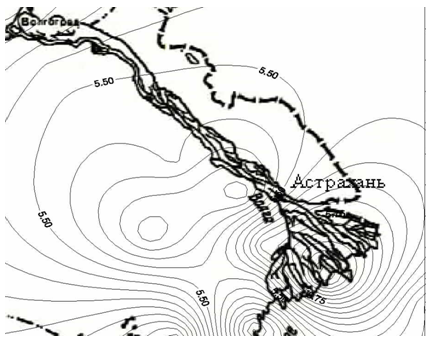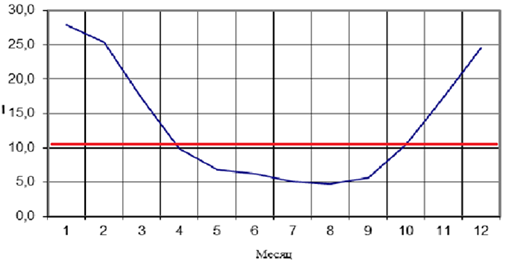ОЦЕНКА ДИСКОМФОРТНОСТИ КЛИМАТА АСТРАХАНСКОЙ ОБЛАСТИ
Иошпа А.Р.1, Коломойченко А.Е.2
1ORCID: 0000-0003-4573-4393, Кандидат географических наук, Доцент, Южный федеральный университет, 2ORCID: 0000-0001-8831-9128, Кандидат филологических наук, Доцент, Днепропетровский национальный университет им. О. Гончара
ОЦЕНКА ДИСКОМФОРТНОСТИ КЛИМАТА АСТРАХАНСКОЙ ОБЛАСТИ
Аннотация
Тепловое состояние человека (переохлаждение, перегрев), сопровождающееся сильным и чрезмерным напряжением систем терморегуляции, требует безотлагательных мер для его улучшения и может выступать ведущим показателем снижения эффективности производства работ на открытом воздухе в зависимости от неблагоприятного воздействия климата. Проведенные исследования позволили впервые оценить биоклиматический потенциал Астраханской области.
Ключевые слова: индекс патогенности, теплый сезон, холодный сезон, метеотропность.Ioshpa A.R.1, Kolomoychenko O.E.2
1ORCID: 0000-0003-4573-4393, MD, Associate Professor, Southern Federal University, 2ORCID: 0000-0001-8831-9128, MD, Associate Professor, Oles Honchar Dnipropetrovsk National University
ASSESSMENT OF CLIMATE UNEASE IN ASTRAKHAN REGION
Abstract
People thermal condition (hypothermia, overheating), accompanied by strong and excessive thermoregulation systems voltage, requires urgent actions to improve it and can be as a leading indicator of the effectiveness decline of outdoors work production depending on the adverse effects of climate changing. Studies allowed to evaluate photovoltaic capacity of Astrakhan region for the first time.
Keywords: pathogenicity index, a warm season, a cool season, meteodependent.Comfort (unease), which objectively reflects the thermal conditions of the person, is one of the main criteria of the climate quality. It is a critical thermal condition of the person (hypothermia, overheating), accompanied by a strong and excessive tension of thermoregulation system that requires urgent measures for its improvement and can be a leading indicator of decline of work production efficiency outdoors, depending on the adverse impact of climate. The reaction link of the human body with the intensity impact of the environment parameters is shown in the classification of weathers moment by V.I.Rusanov the most successfully [7] which takes into account that the voltage of thermoregulation systems in the area of environmental tolerance (the interval between the upper and lower critical points - overheating and overcooling) varies from comfortable to excessive. The particularities of light and ultraviolet modes, the sharp fluctuations of weather and favorable warm period are also very important for human life.
Five rises (0.5, 11, 16, 20, 24 hours) and five recessions (2, 9,14, 18, 22 hours) are recorded in the human daily physiological tonus [5]. The coincidence of the rise and recession periods of biological rhythms with the coming weather changes can enhance or weaken the meteolability effect.
Meteorotropic reactions occur not only during a sharp change in the weather, but also during an enhanced stability of the same type of weather with a distinct influence of some meteorological quantities, usually it is typical for the Astrakhan region an increased pressure with high temperatures in summer. In addition to deterioration of health in this case "weather-mental" stresses, meteorological disadaptation neurosises may occur. [3] As a result, we can face with the weakened attention, an increase in the number of accidents at work, etc.
The research allowed us to evaluate the bioclimatic potential of the Astrakhan region for the first time. We used the method based on the calculation of the clinical index of the weather for the bioclimatic assessment of weather conditions [1].. The index of pathogenicity is defined as a mathematical function of the weather parameters. Meteorological, helio- and geophysical factors are considered as external perturbations affecting the people at the same time with the factors of the internal environment of the human body. A comprehensive index of pathogenicity (CIP) is the sum of the partial indices of pathogenicity, each of them reflects the dynamics of the weather according to a change of air temperature, humidity, wind speed, cloudiness, day to day changes in atmospheric pressure and so on. The optimal meteorological parameters, when there is a minimum of meteopathic reactions: temperature + 18 ° C, relative humidity 50%, wind speed 0 m / s, cloudiness 0 points, the variability of pressure 0 mb / d, the variability of temperature 0 ° C / day.
It should be emphasized that the total index of pathogenicity does not indicate the nature of the changes in the weather, but only to the degree of its irritating effect on the human body. The risk of negative meteopathic reactions in human at annoying weathers is twice more than the optimal, and at incisive is three times more than at the annoying. A bioclimatic assessment of weather conditions was carried out taking into account the seasonal changes in meteorological characteristics [5].
According to the calculations the index of weather pathogenicity in the Astrakhan region is 13.2 points in the average during the year, it means that in this area the weather conditions are evaluated as annoying throughout the year. The maximum value occurs in January in Kapustin Yar area (I = 30,1), a minimum is in Liman, Bir.Kosa (I = 4,4) in August. The optimal month from the standpoint of the pathogenicity index of the meteorological situation out of all the months is August [4].
We conducted regionalization of Astrakhan region using the index of pathogenicity for warm (Figure 1) and cold (Figure 2) periods on the basis of the synthesis of significant indicators of the impact intensity of meteorological parameters on the human, the influence of their duration on the degree of favorability of residence [4].

Fig. 1 -Regionalization in the Astrakhan region according to pathogenicity index in the warm season [4]
The seasonal distribution of the year (Figure 3) showed that the weather conditions in the period from May to September are optimal and comfortable. The most optimal weather conditions remain in the coastal areas of the Astrakhan region: Liman, Karaul'noye, and Bir.Kosa Zelenga from April to October.
The warm season of the year in Astrakhan region is increasingly characterized by comfortable or close to them bioclimatic conditions in almost all indicators, including index of pathogenicity of the meteorological situation [4].
The cold season of the year is characterized by extreme activity of synoptic processes and local circulation as a whole, which causes bioclimatic discomfort

Fig. 2- Regionalization in the Astrakhan region according to pathogenicity index in the cold season [4].
according to all selected indicators, as well as to index of pathogenicity.
It is characterized by a sharp jump in the pathogenicity index of the meteorological situation towards increasing for the cold period (frost), a period when the average temperature according to long-term observations less than 0º C. All this period is characterized as incisive (over 24 points), except for Liman, and where there are no strong weather conditions and index of pathogenicity is less than 22 points throughout the year (Figure 2) [4].
The annual course of index of pathogenicity (Figure 3) shows that the most "annoying" effect of weather conditions is observed during the winter. According to E.G.Golovina [2] and V.I.Rusanov [7] more dramatic value of the index of pathogenicity of the meteorological situation combines with unfavorable shifts in geodynamic parameters of the body (blood pressure, stroke and minute heart rate),

Fig. 3- The annual course of index of pathogenicity [4]
lower average values of electrical membrane permeability (EMP) of blood, and lower incidence of sudden death. A high rank correlation coefficient for the latest situation confirms the high link between index of pathogenicity and meteopathic reactions.
The human living conditions may get worse significantly under the anthropogenic influence in the process of industrial development in all subzones. Taking into account that recently in Astrakhan region has considerably worsened the environmental situation and there is a constant increase in population morbidity, which is associated with the launch of the Astrakhan gas condensate plant [6].
Список литературы / References
- Бокша В.Г., Богуцкий Б.В. Медицинская климатология и климатотерапия.- Киев: Здоровье, 1980.- 264с.
- Головина Е.Г., Трубина М.А. Методика расчетов биометеорологических параметров (индексов) - СПб, 1997. 23 с
- Данишевский Г.М. Акклиматизация человека на севере. - М.: Медгиз, 1955.-358 с.
- Иошпа А.Р. Особенности биоклиматического режима региона на примере Астраханской области: дис. … канд. географ. наук: 25.00.30: защищена 29.12.05 : утв. 14.04.06 / Иошпа Александр Рувимович. – Санкт-Петербург: РГГМУ., 2005. – 148 с.
- Исаев А.А. Экологическая климатология.-М.:Научный мир, 2003.- 472с.
- Малхазова С.М. Медико-географический анализ территорий: картографирование, оценка, прогноз.- М.: Научный мир, 2001.- 240с.
- Русанов В.И Методы исследования климата для медицинских целей.- Томск.: Изд-во ТГУ,1973.-191с.
Список литературы на английском языке / References in English
- BokshaG., Bogutskiy B.V. Меdicinskaja klimatologija i klimatoterapija [Medical climatology and Climatotherapy].-Kiev:Zgorov'e,1980.-264p. (in Russian)
- Golovina E.G.,Trubina M.A.Мetodika raschetov biometeorologicheskih parametrov (indeksov)[Method of calculation of biometeorological parameters (indexes)]- S.-Pb., 1997.-23 (in Russian)
- DanishevskiyM.. Аkklimatizacija cheloveka na severe [Acclimatization of human in the north].-M.:Medgiz,1955.-358p. (in Russian)
- IoshpaR. Оsobennosti bioklimaticheskogo rezhima regiona na primere Аstrahanskoi oblasti [Particular bioclimatic mode region on the example of the Astrakhan region].: dis. … of PhD in Geography: 25.00.30 : defense of the thesis 29.12.05 : approved 14.04.2006 / Ioshpa Alexsander Ruvimovsh. – S.-Pb: RGGMU, 2005. – 159p. [in Russian]
- Isaev A.A. Jekologicheskaja klimatologija [Ecological climatology]. - M.: Nauchnyи mir,2003.-472p. (in Russian)
- Malkhazova S. M. Мediko-geograficheskiianaliz terrltorii: kartografirovanie, ocenka, prognoz [Medical and geographical analysis of areas: mapping, assessment, prognosis].- M.: Nauchnyи mir,2003.-240p. (in Russian)
- Rusanov V.I. Мetody issledovanija klimata dlja medicinskih celeja [Methods of climate research for medical purposes].- Tomsk: Izd-vo TGU,1973.-191p. (in Russian)
